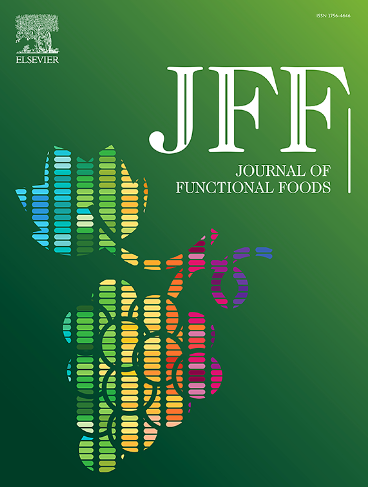Dihydromyricetin attenuates aflatoxin B1-induced IEC-6 cell damage and intestinal damage in mice by activating the Nrf2/HO-1 signaling pathway and modulation of gut microbiota.
IF 4
2区 农林科学
Q2 FOOD SCIENCE & TECHNOLOGY
引用次数: 0
Abstract
Aflatoxin B1 (AFB1) is commonly found in food and feed and has toxic effects on the gastrointestinal tract, impacting public health and livestock development. Dihydromyricetin (DHM) is a natural oxanthrone that has been proven to have significant protective effects on the intestines. This study aimed to elucidate the potential mechanism of DHM alleviating AFB1 exposure-intestinal toxicity in mice. In vitro, rat small intestinal crypt epithelial cells (IEC-6) were treated with aflatoxin B1 (0–120 μmol/L) and DHM (0–320 μmol/L). In vivo, BALB/c mice were divided into four groups: control, AFB1(200 μg/kg), DHM-L (AFB1 + DHM-100 mg/kg), and DHM-H (AFB1 + DHM-200 mg/kg), and gavaged for 30 days. The results showed that the viability of IEC-6 cells decreased with increasing mycotoxin concentration. In addition, RT-qPCR, Western blot, and immunofluorescence results showed that DHM significantly reversed AFB1-induced down-regulation of tight junction proteins, inhibition of the Nrf2/HO-1 signaling pathway, increased expression levels of Caspase-3, Bax, and inflammatory factors, and decreased Bcl-2 levels. In in vivo experiments, we also found that chorionic villus height and crypt depth, expression levels of tight junction proteins, Nrf2/HO-1 signaling pathway, Bax, Bcl-2, Caspase-3, and inflammatory factors, as well as intestinal microbiota, were significantly adversely affected in AFB1-exposed mice. However, the microbial diversity was significantly improved and enhanced by the DHM intervention. In conclusion, DHM intervention attenuated aflatoxin B1-induced intestinal injury by remodeling the gut microbiota, activating the Nrf2/HO-1 signaling pathway, strengthening the intestinal barrier, reducing apoptosis, and inhibiting the release of pro-inflammatory cytokines.

二氢杨梅素通过激活Nrf2/HO-1信号通路和调节肠道菌群,减轻黄曲霉毒素b1诱导的小鼠IEC-6细胞损伤和肠道损伤。
黄曲霉毒素B1 (AFB1)常见于食品和饲料中,对胃肠道有毒性作用,影响公众健康和牲畜发展。二氢杨梅素(DHM)是一种天然的牛黄酮,已被证明对肠道有显著的保护作用。本研究旨在阐明DHM减轻AFB1暴露小鼠肠道毒性的潜在机制。体外分别用黄曲霉毒素B1 (0 ~ 120 μmol/L)和DHM (0 ~ 320 μmol/L)处理大鼠小肠隐窝上皮细胞(IEC-6)。在体内将BALB/c小鼠分为对照组、AFB1组(200 μg/kg)、DHM-L组(AFB1 + DHM-100 mg/kg)、DHM-H组(AFB1 + DHM-200 mg/kg),灌胃30 d。结果表明,随着霉菌毒素浓度的增加,IEC-6细胞活力降低。此外,RT-qPCR、Western blot和免疫荧光结果显示,DHM显著逆转了afb1诱导的紧密连接蛋白下调、Nrf2/HO-1信号通路抑制、Caspase-3、Bax和炎症因子表达水平升高、Bcl-2水平降低。在体内实验中,我们还发现afb1暴露小鼠的绒毛膜绒毛高度和隐窝深度、紧密连接蛋白、Nrf2/HO-1信号通路、Bax、Bcl-2、Caspase-3、炎症因子以及肠道微生物群的表达水平均受到显著不利影响。然而,DHM干预显著改善和增强了微生物多样性。综上所述,DHM干预通过重塑肠道菌群,激活Nrf2/HO-1信号通路,增强肠道屏障,减少细胞凋亡,抑制促炎细胞因子的释放来减轻黄曲霉毒素b1诱导的肠道损伤。
本文章由计算机程序翻译,如有差异,请以英文原文为准。
求助全文
约1分钟内获得全文
求助全文
来源期刊

Journal of Functional Foods
FOOD SCIENCE & TECHNOLOGY-
CiteScore
9.60
自引率
1.80%
发文量
428
审稿时长
76 days
期刊介绍:
Journal of Functional Foods continues with the same aims and scope, editorial team, submission system and rigorous peer review. We give authors the possibility to publish their top-quality papers in a well-established leading journal in the food and nutrition fields. The Journal will keep its rigorous criteria to screen high impact research addressing relevant scientific topics and performed by sound methodologies.
The Journal of Functional Foods aims to bring together the results of fundamental and applied research into healthy foods and biologically active food ingredients.
The Journal is centered in the specific area at the boundaries among food technology, nutrition and health welcoming papers having a good interdisciplinary approach. The Journal will cover the fields of plant bioactives; dietary fibre, probiotics; functional lipids; bioactive peptides; vitamins, minerals and botanicals and other dietary supplements. Nutritional and technological aspects related to the development of functional foods and beverages are of core interest to the journal. Experimental works dealing with food digestion, bioavailability of food bioactives and on the mechanisms by which foods and their components are able to modulate physiological parameters connected with disease prevention are of particular interest as well as those dealing with personalized nutrition and nutritional needs in pathological subjects.
 求助内容:
求助内容: 应助结果提醒方式:
应助结果提醒方式:


